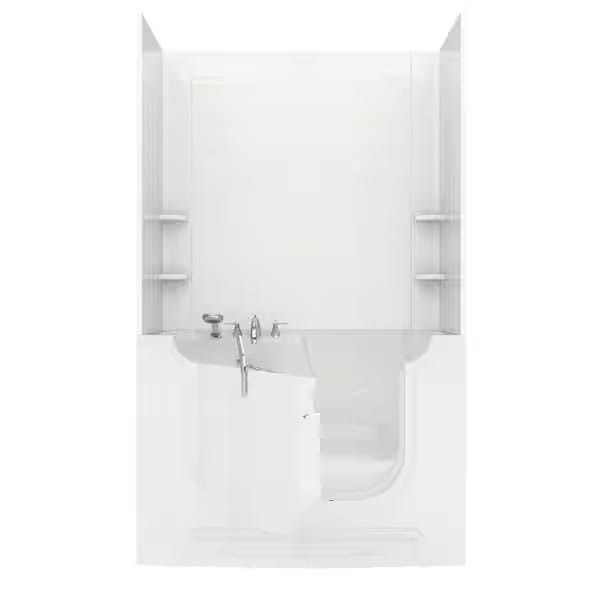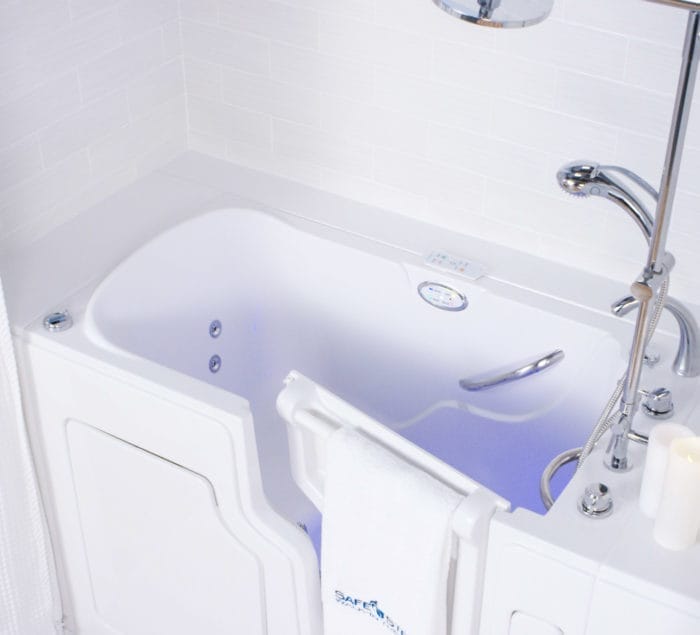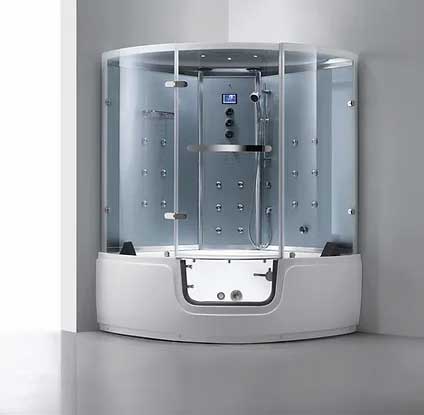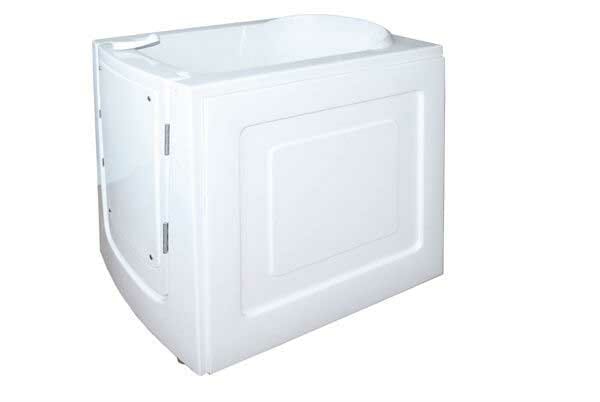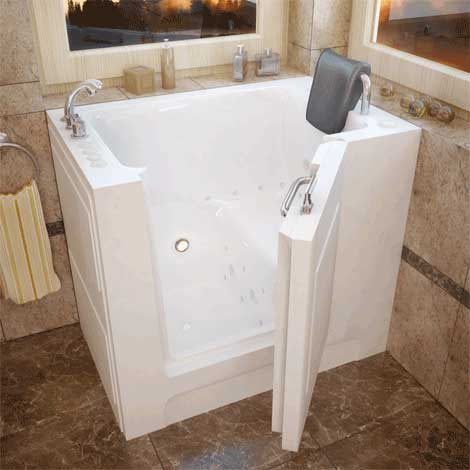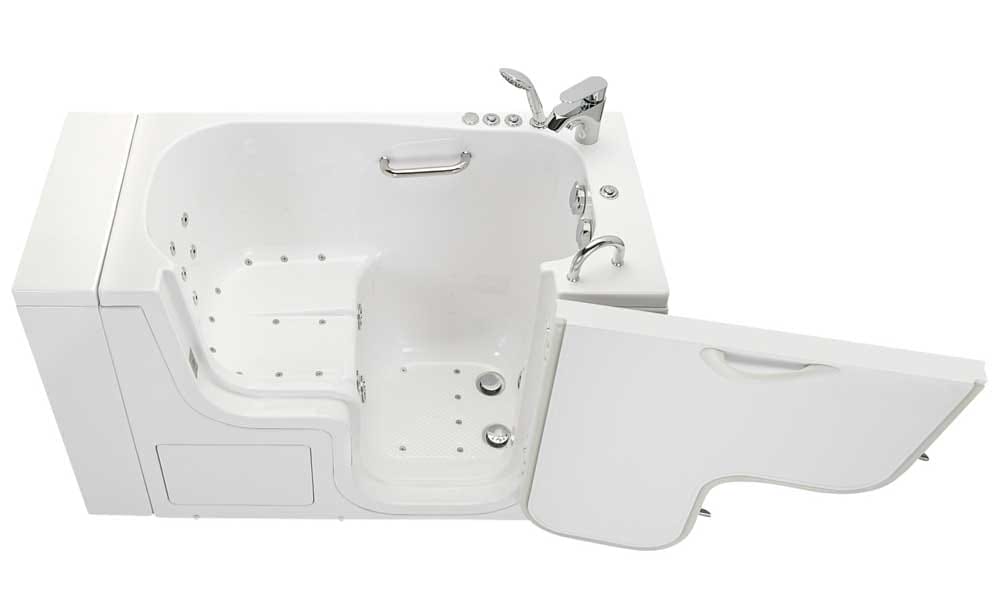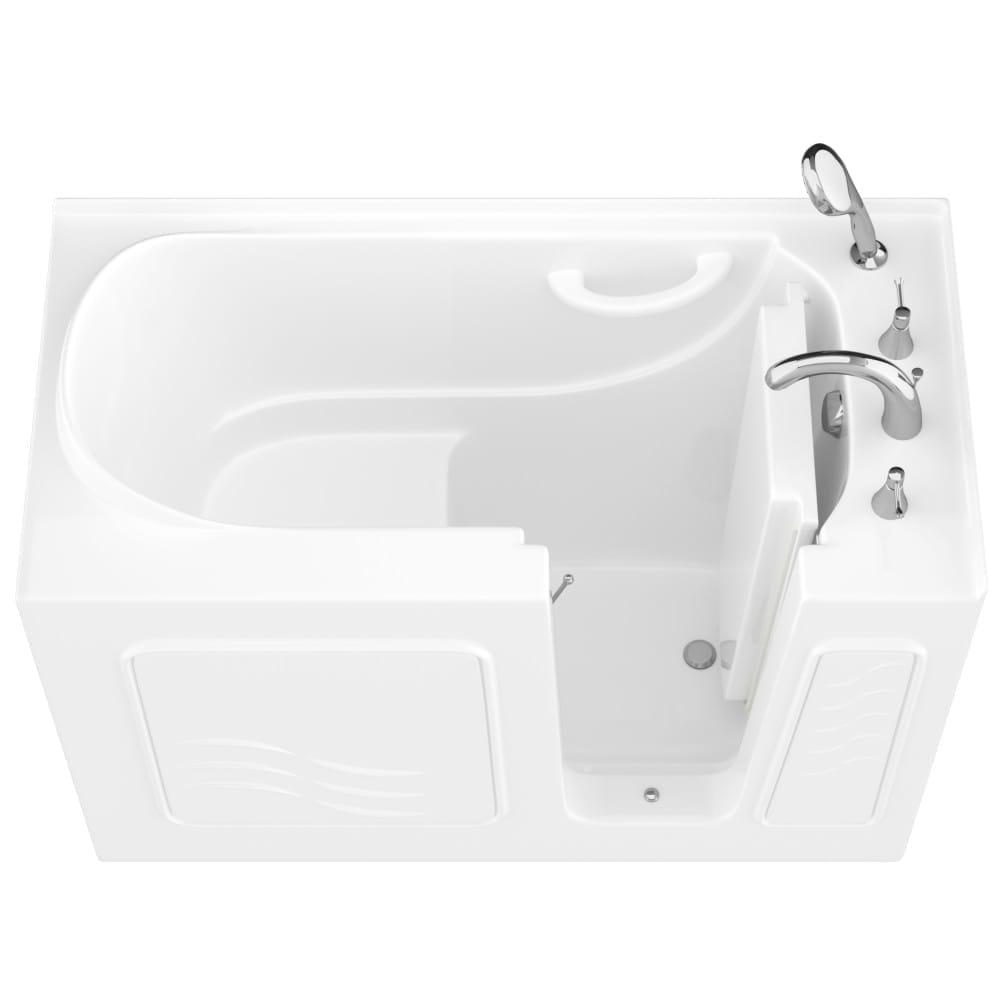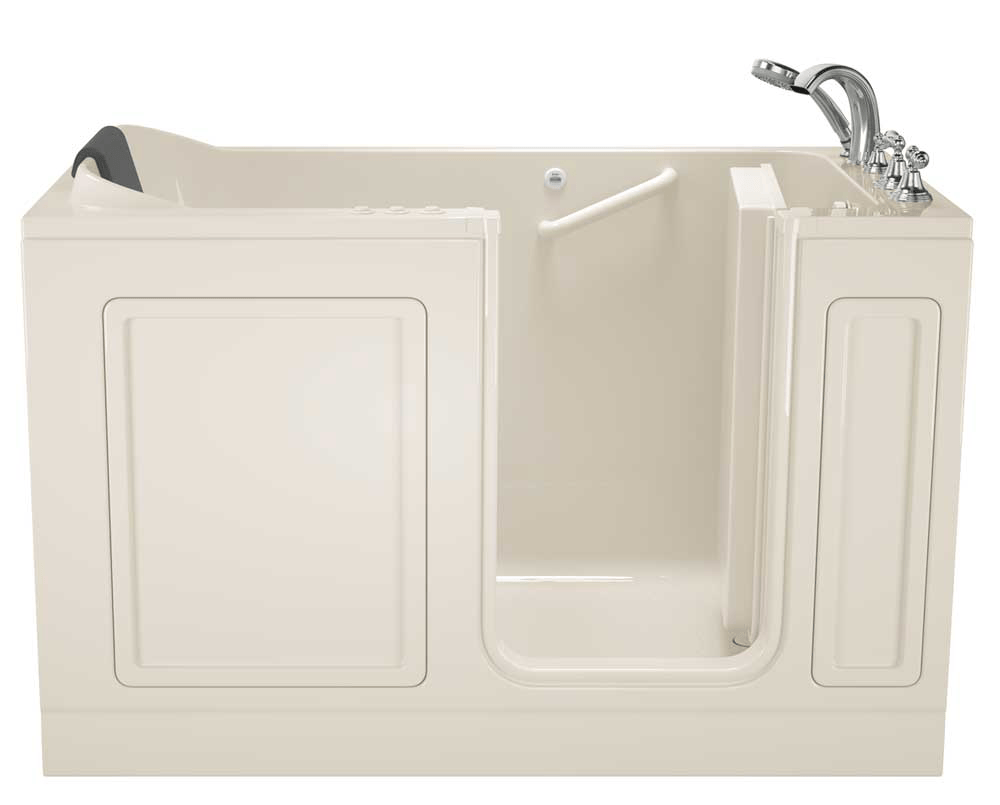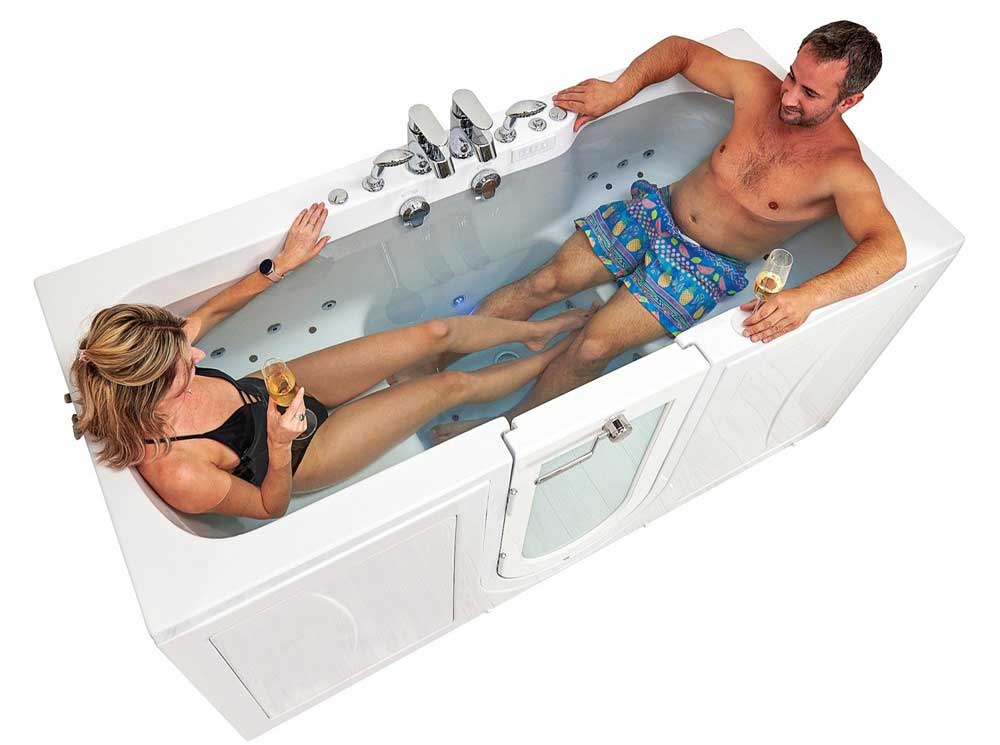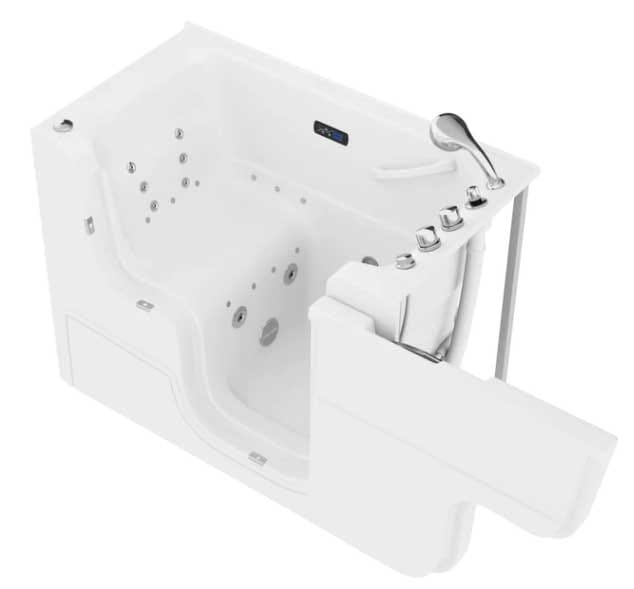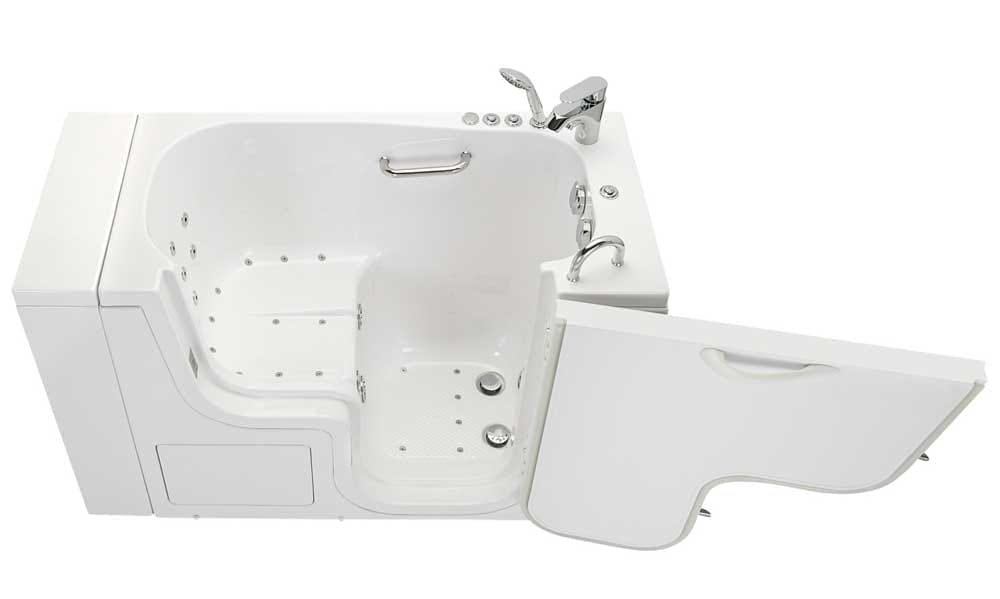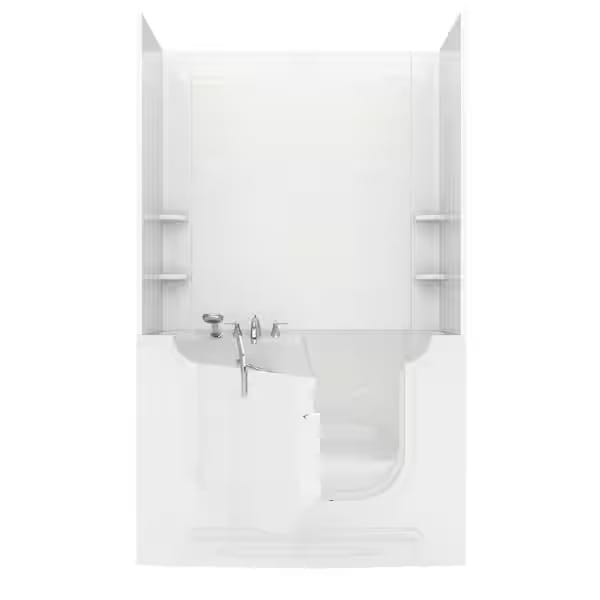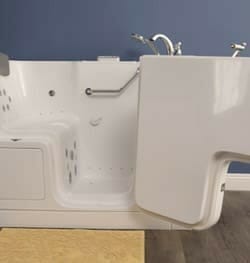You or a loved one might need a walk-in tub to bathe safely and comfortably as you or they age. The swinging doors, low entry thresholds, and grab bars included with walk-in tubs can reduce the possibility of slips and falls in the bathroom. The right tub can come with features like jets and chromotherapy, making bathing more luxurious than the standard tub and shower combo you’re used to.
Purchasing and installing a walk-in tub is an investment. When even the most affordable tub costs over $1,000 before installation, choosing the best walk-in tub is important.
So, which tub is right for you?
Whether you’re looking for the best deal, the most features, or the best wheelchair-accessible tub, we’ve got you covered.
Here are our top five best walk-in tubs of 2023.
Best walk-in tub for people on a budget
Anzzi fully loaded walk-in tub
Pros:
- Includes aromatherapy massage bubbles.
- Soft-touch console with LED lights.
- 10 adjustable hydrotherapeutic whirlpool massage jets.
- 18 Acu-Stream air jets.
- Inline water heater.
- Quick Fill waterfall faucet with Euro-grip showerhead.
- ADA-compliant features, like a grab bar and built-in seat.
- Lifetime warranty on watertight pressure seal, a 10-year warranty on marine-grade acrylic tub shell, and a one-year warranty on parts.
Cons:
- Inward-swinging door.
- May not be comfortable for larger bathers.
- Mixed reviews on Amazon.
- Curbside delivery only with no option for installation.
If you’re looking for the most bang for your buck, look no further than the Anzzi fully loaded walk-in tub.
You may be able to find more affordable tubs out there, but those don’t come with features like massage jets and inline heating. The Anzzi fully loaded walk-in tub has all that and more at a lower price than other tubs on the market.
This walk-in bathtub includes aromatherapy massage bubbles, hydrotherapeutic whirlpool massage and Acu-Stream air jets, an inline heater, and chromotherapy, where colored lights emit from within the tub. These features are soothing and relaxing and can help reduce swelling and decrease inflammation from arthritis and other conditions, all while keeping the water warm so you can rest, relax, and rejuvenate for as long as you want.
There’s no doubt that soaking in this Anzzi tub is relaxing, but additional features ensure your safety, too. The tub has grab bars, slip-resistant textured flooring, and a low entry threshold. You can choose a left- or right-swinging door with corresponding drain placement, so you can find the tub that works best for your bathroom without extensive remodeling.
The only downside is that the door on this walk-in tub swings inward. Although it saves space in a tight bathroom, it can make getting into and out of the tub difficult.
The tub has a relatively compact size of 52.5 by 26.5 by 44.5 inches, which is great for smaller spaces, but the small size can make the tub uncomfortable for some people.
This walk-in bathtub has various warranties on the shell, parts, and door seal, but installation might be challenging. Whether you purchase the tub from Amazon or Anzzi, installation is not included. When delivered, the tub will be left on the curb, so it’s up to you to get it into your home and either install it yourself or hire a professional.
Cost at time of publishing: $2,750.00-$3,495.00
Visit Anzzi to purchase the right-drain or left-drain walk-in tub
Buy the Anzzi fully loaded walk-in tub on Amazon
Best wheelchair-accessible tub
Ella Transfer Series
Pros:
- Hydro jets and air jets available.
- Variety of sizes.
- Your choice of right or left drain.
- Large outward-swinging L-shaped door with molded seat.
- Fast-fill faucet and dual-drain technology.
- Auto-purge maintenance system and ozone sterilization system.
- Options to upgrade to a heated seat, digital keypad, and more.
- Assembled and tested in the USA.
- Limited lifetime warranty on all tubs.
Cons:
- Tubs are pricier than comparable options.
- Shopping for an Ella tub at Home Depot can be confusing.
- You must contact a representative when shopping on Ella’s website.
Ella is among the leaders in the walk-in tub industry because of their craftsmanship, quality, and customer service. The Ella Transfer Series is our top pick for the best wheelchair-accessible tubs because they offer several sizes. Their wheelchair-accessible walk-in bathtubs come in the following sizes:
- 26″ x 52″ with a 19″ seat.
- 30″ x 52″ with a 22″ seat.
- 32″ x 52″ with a 24″ seat.
- 30″ x 60″ with a 22″ seat.
- 36″ x 55″ with a 29″ seat.
No matter which size you choose, you will still enjoy the same features.
Ella Transfer Series tubs feature a large, L-shaped, outward-swinging door, which makes sliding into and out of the molded seat easy for wheelchair users and those with mobility challenges. Each tub includes a fast-fill faucet and dual-drain technology that quickly fills and drains the tub.
You can customize your tub with hydro jets, air jets, and foot massage capabilities. If you choose a model with jets, the built-in auto-purge maintenance and ozone sterilization systems will keep your tub functional and clean with little effort.
You can choose whether the door swings to the left or right. You can also upgrade to a digital keypad, include a heated seat and back, add a folding glass shower screen, buy a padded headrest, and much more.
Ella offers financing, professional installation, and an exhaustive list of customization options. You get peace of mind in knowing their tubs are assembled and tested in the USA and that a limited lifetime warranty covers their parts.
All that does come at a cost. Ella’s wheelchair-accessible walk-in tubs start at nearly $5,000. The more features you add, the more expensive it gets, especially considering the price doesn’t include installation.
Cost at time of publishing: $4,900.00-$8,128.00
Visit Ella’s Bubbles to learn more
Buy an Ella tub at Home Depot
[Check out our other favorite wheelchair-accessible walk-in tubs]
Best feature-rich walk-in tub
Total Care in Bathing Fully Loaded walk-in tub
Pros:
- 20 air jets, 10 whirlpool jets, and one bidet jet.
- Option to include exclusive LED faucet light kit.
- Aromatherapy and chromotherapy included.
- Ozone sanitization to keep the tub clean.
- Your choice of left or right drain.
- U-shaped grab bar at the front of the tub.
- Low 4.5-inch step-in height.
- Fast drain system.
- Lifetime warranty on the watertight door seal, shell, frame, and finish.
Cons:
- Door swings inward.
- The Total Care in Bathing website feels dated.
The Fully Loaded walk-in tub from Total Care in Bathing is our top choice if you want the ultimate bathing experience. If there’s a feature a walk-in bathtub can have, this tub has it.
It is packed with air and whirlpool jets strategically placed to massage the back, lower legs, and feet. It even includes a bidet jet, which not all jetted walk-in tubs have.
Aromatherapy and chromotherapy are included, as well as an ozone sanitization system that keeps your tub clean so body oils and soaps don’t clog your tub. A built-in heat exchanger ensures the water stays warm, no matter how long you soak, while a revolutionary Syllent pump offers an exceptionally quiet and efficient whirlpool bathing experience.
It’s all controlled with raised buttons to personalize your bathing experience, including an individual knob for the bidet. You can upgrade to an LED faucet light kit that integrates with the tub’s chromotherapy feature for an even more luxurious experience.
Although this tub is fully loaded, safety is still top of mind when it comes to its design. This model has a low 4.5-inch step-in height with an ADA-compliant contoured seat, a U-shaped grab bar at the front of the tub, and an angled grab bar inside. It includes a handheld showerhead, a textured nonslip floor, and a secondary door drain for faster draining. You have your choice between left or right drain placement. The only downside to this tub’s design is that the door swings inward, which can make getting into and out of the tub difficult.
Each tub is assembled by hand and individually tested before being shipped. You get a lifetime warranty on the door seal, shell, frame, and finish and a 10-year replacement warranty on all other parts.
This tub comes with a luxury price tag, but it is quite affordable compared to the cost of other similar tubs. Just keep in mind that the cost doesn’t include installation.
You can purchase the tub at Lowe’s or buy it directly from the manufacturer. Although the Total Care in Bathing website is dated, it includes a lot of helpful information. You can contact order specialists, even in the evenings and on weekends, who can answer your questions before you make a purchase.
Cost at time of publishing: $5,929.00
Visit Total Care in Bathing to learn more
Buy the Total Care in Bathing Fully Loaded walk-in tub at Lowe’s
[Check out more of our favorite feature-rich walk-in tubs]
Best walk-in tub and shower combination
Universal Tubs wheelchair-accessible tub with shower surround
Pros:
- Includes 26 air bubble jets.
- Includes aromatherapy and chromotherapy.
- Water drains in under 60 seconds.
- Your choice of right- or left-swinging door.
- Extra-wide door exposes the seat.
- Professional installation available through Universal Tubs.
- Extended warranty coverage for up to 10 years, depending on the part.
- Lifetime warranty on the door seal.
Cons:
- Standard showerhead must be purchased separately.
- Constructed out of fiberglass with a gel coat, which can crack and fade more quickly than acrylic.
Universal Tubs is a top name in walk-in tubs. Made in the USA, all their tubs come with warranties on the tub shell, wall surround, door seal, components, and labor. They always make best-of lists, but when it comes to the best tub and shower combination, Universal Tubs goes above and beyond with their wheelchair-accessible tub and shower surround.
This walk-in tub and shower combination has plenty of bells and whistles to provide a relaxing bathing experience. Aromatherapy engages your sense of smell, chromotherapy visually soothes you with colored lights in the tub, and 26 air bubble jets engage your sense of touch. A thermal heated seat backrest keeps the water warm without refilling the tub.
The outward-swinging door is one of our favorite accessibility features on this tub. As an oversized door, it’s larger than typical L-shaped wheelchair-accessible doors. It exposes the entire seat and the footwell, making it extremely easy to get into and out of the tub, even if you require assistance. You also have your choice of right or left drain placement. Just make sure you compare tubs carefully, as listings on the Home Depot website can be confusing, especially regarding drain and door placement.
The kit on the Home Depot website includes everything you need to install the shower surround, but you’ll have to install it yourself. This tub and shower combo kit has a handheld showerhead but not a traditional one, so you must purchase and install it separately.
It’s common for walk-in tubs to be constructed out of gel-coated fiberglass. These tubs are sturdy but can fade, discolor, and crack more easily than acrylic tubs. You may want to consider an alternative if you’re looking for a long-term installation.
If you want to ensure you get the exact right tub and don’t want to worry about installing the tub yourself, consider purchasing the wheelchair-accessible tub and shower surround directly from Universal Tubs. Although tub and shower combos aren’t explicitly listed on their website, a customer service representative can help you customize your walk-in tub and shower combo with the right details and schedule your installation.
Cost at time of publishing: $6,109
Visit Universal Tubs to learn more
Buy a Universal Tubs right-drain or left-drain walk-in tub with shower surround at Home Depot
[Check out more of our favorite tub and shower combos]
Best walk-in tub for small spaces
Mobility Bathworks Elite 3338 walk-in tub
Pros:
- One of the smallest footprints available at just 33″ x 38″ x 38″.
- Chromotherapy and aromatherapy available at no additional cost.
- Your choice of color, door placement, faucets, and more.
- Built-in grab bar and anti-slip flooring.
- Pipeless jetted whirlpool system and ozone sterilizer available.
- 25-year warranty on the tub body, with a lifetime warranty on the door, seal, and air jets.
- Best-price guarantee.
Cons:
- Additional features, like a heated backrest and double drain system, cost extra.
- Small seat and footwell may be uncomfortable for some people.
If you don’t have a lot of room for a walk-in tub, check out the Elite 3338 tub from Mobility Bathworks. With a footprint of just 33 by 38 by 38 inches, it is perfect for even the smallest spaces. It’s also a good choice if you would like to add a walk-in tub to your existing bathroom without removing or replacing your existing tub or shower.
Just because this tub is small doesn’t mean you won’t get an elevated bathing experience. You can add water jets, a heated seat, and an ozone sterilizer. You can also include comfort and convenience features, like a headrest pillow and a double drain system.
Although these add-ons come with additional costs, some features are available for free. You can choose the tub color and door placement and select a faucet at no extra cost. You can also add chromotherapy and aromatherapy features for free, and grab bars and anti-slip flooring are included at no charge.
This walk-in tub is one of our favorite budget tubs; the base price starts at just $2,377.00. There’s a 25-year warranty on the tub body and a lifetime warranty on the door, seal, and air jets. If you buy your tub from Discover My Mobility, you’ll get free shipping and a best-price guarantee: If you find a better price for this tub, they will match it and give you 10% of the difference.
Although this walk-in bathtub’s small footprint makes it ideal for small spaces, it is important to consider whether or not it will be comfortable. This tub has a scant 17-inch seat, which can make bathing uncomfortable or downright impossible for some people. Its small size also prevents you from leaning back or stretching your legs.
Cost at time of publishing: $2,377.00
Visit Mobility Bathworks to learn more
Buy a Mobility Bathworks Elite 3338 walk-in tub at Discover My Mobility
[Check out more of our favorite walk-in tubs for small spaces]
How to choose the best walk-in bathtub
A walk-in tub can transform how you bathe, providing you and your loved ones with comfort, safety, and peace of mind. When walk-in bathtubs cost thousands of dollars, and the safety of you or your loved one is on the line, it’s important to choose one that’s right for you. How do you narrow your options with so many different kinds of tubs and features?
Know your measurements
It’s important to measure your space before you start shopping. Do you need a walk-in tub that fits into the space of a traditional tub and shower combo? Do you need a slim tub, or do you have enough room for a wider seat? Will the swinging door open fully, or will another fixture, like a sink or toilet, get in the way?
You should also determine what size seat you need, as smaller-size seats can be uncomfortable for some people. Pay attention to threshold measurements, too. How high of a threshold can you step over?
Iron out these measurements beforehand so you get the perfect tub — not too big, not too small, but just right.
Know your budget
The cost of walk-in tubs and showers can vary widely. Narrow down your choices by working out what you’re willing to spend.
Here are a few things to keep in mind when it comes to budget:
- Many tubs with prices listed online do not include the price of shipping and installation, so make sure you have extra room in your budget for these potential costs.
- Consider calling the manufacturer directly if a tub is outside your price range. They may be able to customize a tub that fits your budget.
- Many manufacturers and vendors offer financing if you can incorporate a monthly payment into your budget.
Make a list of must-haves
What do you need in a walk-in tub? These might be features like:
- ADA-compliant grab bars.
- A built-in seat.
- An outward-swinging door.
- Nonslip flooring.
You may also need a built-in ozone sterilization system because you won’t be able to keep the tub clean on your own, or maybe you need a footwell that you can fill on its own so you can soak your feet without taking a bath.
You can significantly narrow down the seemingly countless options with a list of must-haves. Knowing what you need ensures you pay attention to what’s truly important in a walk-in tub.
Make a list of would-likes
You should also list things you would like but aren’t necessary in a walk-in tub. For example, you might like the idea of a digital keypad, but you could make do with traditional knobs. Or maybe you would like a heated backrest to keep the water warm and relax your muscles.
Finding a tub with your must-haves and a few features you want — that also fits your budget — is a good sign you have found the right tub.
Know what you don’t care about
Getting lost in all the luxury features available in some walk-in tubs can be easy, leading you to forget what you were initially looking for and pay for features you don’t need.
Make sure this doesn’t happen to you by making a list of the features you don’t care about. For example, if you like to burn scented candles while you take a bath, you might not care about aromatherapy. Or maybe you don’t like to take long baths, so you don’t need a heated seat.
Knowing what features you don’t care about makes them less likely to distract you from what you’re looking for, especially if you’re speaking to a customer service representative who might try to upsell you on additional features.
Consider the future
It’s important to think about what you need in a walk-in tub now but also what you might need years down the road.
Do you foresee using a wheelchair more often in the future? Or maybe you want to hire an in-home care aide when the time comes. Thinking about what you might need in the future can help you decide between things like a regular- or L-shaped door and a higher or lower threshold.
Also, consider the future of your home. If you don’t plan on living there for a long time, you might not want to invest in a walk-in tub. If you anticipate others moving into your home to care for you in the future, you may want to consider a walk-in tub and shower combo so they feel comfortable bathing, too.
Plan ahead for delivery and installation
Make sure you think about delivery and installation before you make your final purchase. Big-box stores, like Lowe’s and Home Depot, offer free delivery, but it’s usually only curbside delivery, so you’ll have to figure out how to get your walk-in tub into your home. If this is too much trouble, you’ll want to look into manufacturers who offer door-to-door service.
Think about installation, too. Are you prepared to hire someone to do the job? If so, you’ll want to plan where to store your tub until it can be installed.
Do you want the convenience of having installation included with your purchase? Although it costs more, you don’t have to worry about delivery, storage, or installation, as it is all coordinated for you.















